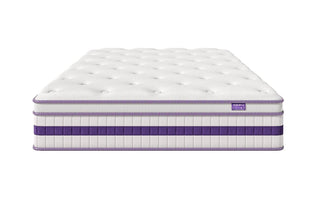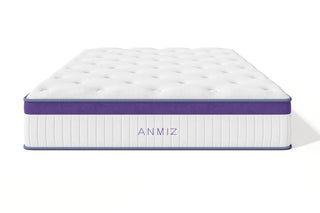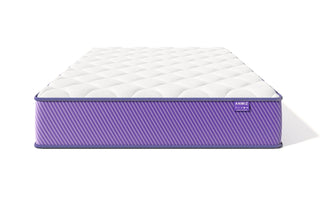Mattresses and Motion Isolation
We occasionally receive free products for testing and take part in affiliate programs, which means we may earn a commission if you purchase items through links on our site. For full details, please refer to our disclosure page.
Whether you share your bed with a partner or a pet, motion isolation is an important factor to consider. If your mattress doesn’t control motion effectively, you might wake up whenever your loved one changes positions beside you.

Why Is Motion Isolation Important?
When you share a bed with someone, you may feel their movements when they shift positions or become restless. In the mattress world, we call this transfer of movement motion transfer.
Couples who sleep together benefit the most from mattresses that isolate motion well. This is especially valuable when partners have different sleep schedules or wake-up times. Even if they don’t, no one wants to be disturbed by a restless partner. The best mattresses for couples are those with excellent motion isolation and reliable edge support.
Pet owners face a similar challenge. Pets often move or jump in and out of bed throughout the night. When this happens, you don’t want to feel that movement on your side. A mattress with strong motion isolation ensures your pet’s nighttime activity doesn’t interrupt your sleep.
How We Test Motion Isolation
At Dweva Mattress, we take motion isolation testing seriously. Each mattress we review is scored out of 5 (with 5 being a perfect score), based on two detailed tests that help us assess real-world performance.

Glass of Water Test
We start by placing a glass of water on top of the mattress and pressing around it. If the water ripples inside the glass, that mattress doesn’t isolate motion well. But if the water remains still, it’s a sign that the mattress offers strong motion control.
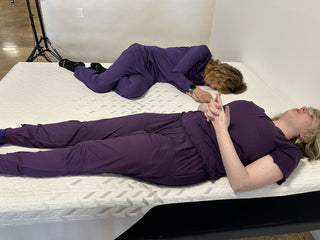
Two-Person Test
While the water test is helpful, the best way to measure motion isolation is to experience it firsthand. In this test, one person lies still on the mattress while another moves or rolls on the other side. If the resting tester feels any movement, the mattress isn’t performing well in motion isolation.
To make the test more accurate, we sometimes have the resting person wear a sleep mask so they can’t anticipate movement. They signal with a thumbs-up whenever they feel motion. Mattresses with great isolation often leave the tester completely unaware that their partner has moved or even gotten into bed.
What Causes Motion Transfer in a Mattress?
A mattress’s ability to isolate motion largely depends on how it’s built. Most mattresses contain several layers of materials, each with its own density and support characteristics.
The base support layer plays a major role. Dense materials such as memory foam absorb movement far better than traditional innerspring coils.
The top comfort layer also affects motion isolation. Thick, high-density layers tend to absorb motion better than thin or less supportive ones.
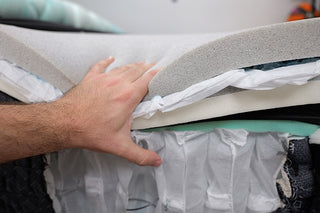
Other factors like material quality, firmness level, and overall thickness also influence motion transfer. In general, thicker mattresses made with high-quality foams are best at limiting movement.
How Materials Affect Motion Transfer
When it comes to motion isolation, material quality and design make all the difference. Let’s look at how different mattress types perform in motion control tests.
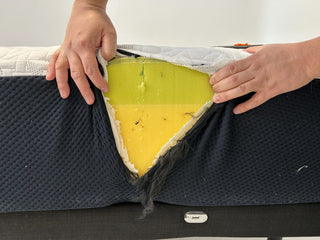
Memory Foam
Memory foam mattresses are known for exceptional motion isolation. Dense foam layers absorb movement efficiently, so you’re less likely to feel your partner move. The denser the foam, the better it performs.
Traditional memory foam also has a slow-responding feel that contours to your body and provides great pressure relief. However, it can sometimes make it harder to move around. Mattresses with that deep, “sinking” feel—like some TEMPUR-Pedic models—are excellent for pain relief but may leave you feeling slightly “stuck” in bed.
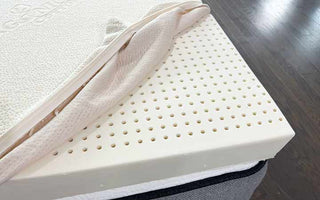
Latex Hybrid
Some latex mattresses do a decent job isolating motion, but overall, they aren’t as effective as memory foam. Latex has a naturally bouncy, responsive texture, so movement on one side often travels across the surface.
There are three main latex types: Talalay, Dunlop, and synthetic. Both Talalay and Dunlop latex are natural, but Dunlop is denser and better at reducing motion transfer. Synthetic latex is more affordable, though it doesn’t absorb motion as well.
On the bright side, latex is easier to move on, naturally cooling, and long-lasting—though it typically comes with a higher price tag.
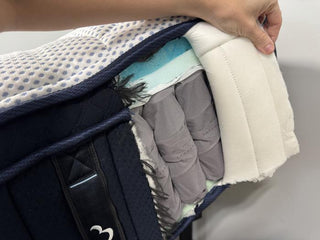
Hybrid
Hybrid mattresses combine multiple materials, often pairing memory foam comfort layers with coil support systems. To qualify as a true hybrid, the comfort layer must be at least 2 inches thick.
Because hybrids use several materials, their motion isolation can vary. Those with thick, high-density foam layers generally perform well, while thinner or lower-quality hybrids may transfer more movement.
Not all memory foam hybrids have the classic slow-moving feel. Some use balanced foams that provide comfort and bounce, so you won’t feel trapped while still enjoying good motion isolation.

Innerspring
Traditional innerspring mattresses typically perform poorly in motion isolation tests. They’re very bouncy and react quickly to movement, which means you’ll feel most shifts in weight.
That said, mattresses with pocketed coils (individually wrapped coils) handle motion better because each coil moves independently, reducing motion transfer across the bed.
Innerspring models usually have thinner comfort layers, meaning you’ll feel the coils underneath more directly. Thin layers can’t absorb motion as effectively as the thick foams used in memory foam or latex beds.
Although innersprings aren’t ideal for motion isolation, they excel in temperature regulation and lumbar support, making them a good choice for hot sleepers or those needing extra back support.



